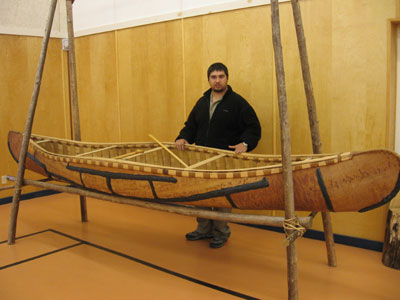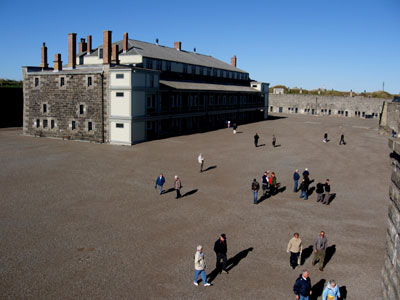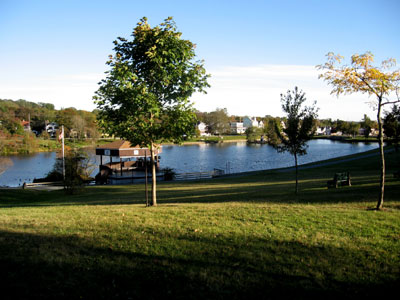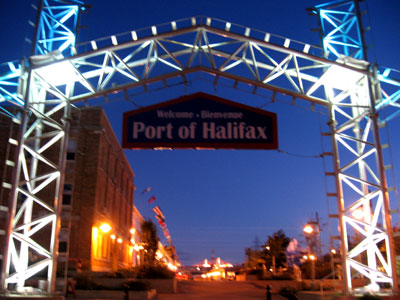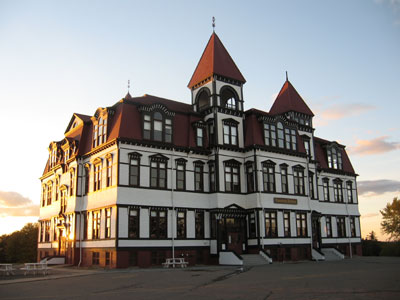The tipi also features a variety of furs, including lynx, rabbit, mink, red fox and silver fox. During the 1920s and 1930s silver foxes were a real fashion craze in England and many women had a fox fur, complete with head and legs, draped around their necks as a statement of elegance. The fox’ head would be equipped with a clasp so it could be clipped onto the lapel of the lady’s coat.

A silver fox worn around the neck, a big fasion item in the 1920s and 1930s
I learned that the wigwam is made of birch bark. Wigwams were lightweight, which made them easy to move from one location to another and water-resistant. Encampments would be set up near the mouth of rivers, which would provide a plentiful opportunity for food and means of travel. A large part of native diet consisted of fish; the rest was made up of berries, fruits and meats. Often fishing weirs were used for catching eels. Wanda explained that in the last few years about 800 encampments have been found in Nova Scotia with more than 4000 artifacts dating back 2,500 to 4,000 years.
Mi’kmaq hunting traditions included bear traps that were baited with fish. Once the animal was caught, women would remove the guts, the hide and the sinews and carry it back to the camp to prepare it. Excess meat and fat would be scraped off the skin with scraping tools, stones or shells. Wanda informs me that women were very highly respected in First Nations society, as they were life givers. Meals were cooked in a hollowed-out log that held red-hot stones that had been heated over a fire. Water would be poured over the food and the hot stones to cook the meal. Spices were gathered in the forest, and instead of potatoes a plant called the Jerusalem artichoke would be served with the meat. Fish and meat were dried or smoked, and eggs were gathered from marsh birds.

Information about the Mi’kmaq Nation
We moved over to a display on Mi’kmaq language and Wanda mentioned that there were 7 Mi’kmaq districts, each with their own chief. The Bear River Reservation is located in a place called “Kespukwik”, meaning “where the water stops flowing”, referring to the Bear River flowing into the Annapolis Basin. Mi’kmaq language is based on action verbs, and pronouns are important indicators of belonging and possession. For instance, the words “mother” or “sister” can never be said by themselves, they always require a pronoun to indicate whose mother we are talking about. The Mi’kmaq words would say “your mother”, “my mother”, or” his/her mother” etc.
At the next display we saw a 1936 picture of Wanda’s great-grandmother, Sarah Fossey who lived until 1961 to the ripe old age of 101. Wanda has fond memories of Sarah who used to bring her grandchildren and great-grandchildren oranges as a special treat. Sarah was captured in a movie from the 1930s that was displayed at the Bear River First Nation Heritage and Cultural Centre. Wanda was overwhelmed when she first saw moving images of her great-grandmother in the movie.

Wanda’s great-grandmother Sarah Fossey is pictured on the left
We also discussed life as a Mi’kmaq today. Wanda explained that Mi’kmaq society was matriarchal until the arrival of the first Europeans. In recent years, from the 1920s to the 1990, the government instituted a policy of residential schools where young native children were taken away from their families and taught the “white man’s ways’. This led to a significant loss in culture and heritage, women’s status eroded as a result and Mi’kmaq family structure suffered. The government wanted to force native children to “integrate” into mainstream society and in the process an ancient way of life was destroyed. Siblings were often not allowed to talk to one another and families were torn apart. Many of the native children suffered from mental, physical and sexual abuse in the residential schools. As a result of these policies, today many elders are learning the Mi’kmaq language from the younger generation.

The challenges of the Mi’kmaq people
Today there is a counter-trend where young First Nations people are rediscovering their language, culture and heritage. Of the conditions at the Bear River Reservation Wanda says that it is a managed forest and there is no poverty on the reserve, which holds about 100 people. Wanda herself has lived off the reserve for her entire life and has been self-efficient.
Wanda also explained that having “native status” is an important issue in First Nations communities. Native status confers certain benefits in terms of health care, taxation and schooling. Bill C31, introduced in 1985, improved native women’s status in the sense that they could pass native status on to their first generation children, even if the children were from a mixed native/non-native marriage. Men on the other hand can pass on native status indefinitely through the generations, even if they marry a non-native wife. This often creates economic inequality and friction within the same family where one set of cousins could have native status whereas another cousin would not officially be considered native. Even fairly recent legislation prolongs the European tradition of favouring male bloodlines.

Welcome to the Bear River First Nation Heritage and Cultural Center
Wanda gave me the names of several books that would provide further education about First Nations life and communities and when I said goodbye, she generously gave me two books to read as a present: “L’sitkuk – The Story of the Bear River Mi’kmaw Community” by Darlene Ricker, and “We Were Not Savages – A Mi’kmaq Perspective on the Collision between European and Native American Civilizations” by Daniel N. Paul, excellent reading material to educate myself further about native culture and history. As a parting gift she gave me a handcrafted medicine pouch that she had made herself, an example of the Mi’kmaq tradition of generosity and peacefulness.
I thanked Wanda and the entire team at the Bear River First Nation Heritage and Cultural Centre for their most interesting introduction to Mi’kmaq heritage and culture and resolved to read these books soon to educate myself. I started driving down the hill and all the people congregated at the local Bear River Band Office waved goodbye to me. It was time for me to continue my drive along the Evangeline Trail to tonight’s final destination: Yarmouth.
